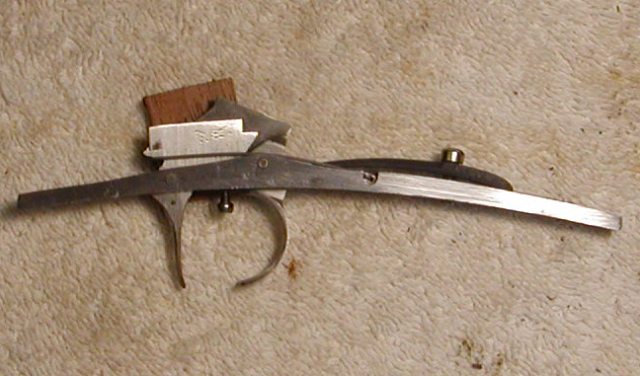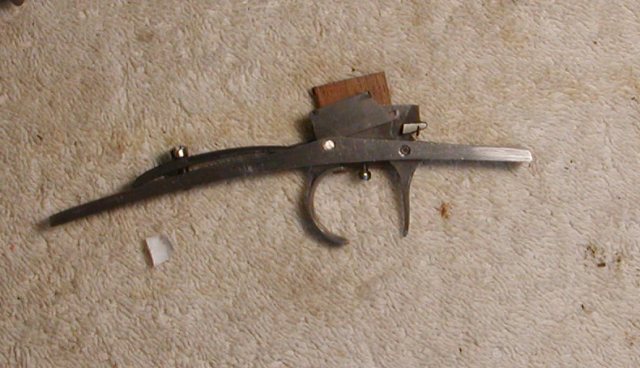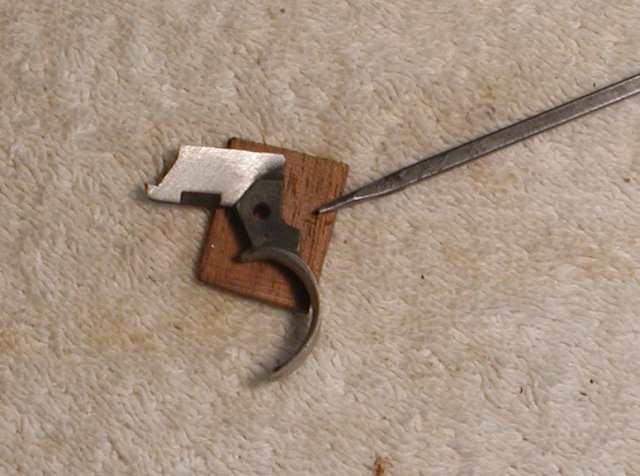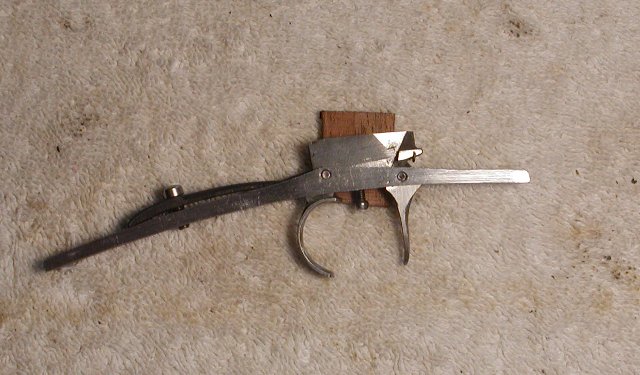Although I have inletted for two double set trigger assemblies on previous builds, it has always been like shooting in the dark for me for getting the trigger assembly in the proper position. Luckilly I got them right. Was thinking that there must be a proper proceedure for doing this. One that alleviates much of the "guesswork". Chime in please and tell me how you do it.
-
This community needs YOUR help today. We rely 100% on Supporting Memberships to fund our efforts. With the ever increasing fees of everything, we need help. We need more Supporting Members, today. Please invest back into this community. I will ship a few decals too in addition to all the account perks you get.

Sign up here: https://www.muzzleloadingforum.com/account/upgrades -
Friends, our 2nd Amendment rights are always under attack and the NRA has been a constant for decades in helping fight that fight.
We have partnered with the NRA to offer you a discount on membership and Muzzleloading Forum gets a small percentage too of each membership, so you are supporting both the NRA and us.
Use this link to sign up please; https://membership.nra.org/recruiters/join/XR045103
You are using an out of date browser. It may not display this or other websites correctly.
You should upgrade or use an alternative browser.
You should upgrade or use an alternative browser.
Inletting for a double set trigger.
- Thread starter pooch156
- Start date

Help Support Muzzleloading Forum:
This site may earn a commission from merchant affiliate
links, including eBay, Amazon, and others.
- Joined
- Nov 26, 2005
- Messages
- 5,010
- Reaction score
- 9,945
Hi,
Fixing poorly installed set triggers is about the third most common task I am asked to do by clients coming into my shop. Most have double lever triggers that "theoretically" can fire the gun set and unset. The most common complaints are that the front trigger pull when unset is horrible, mushy, heavy, lots of creep etc. The second most common issue is they cannot cock the lock without first setting the triggers. There are other issues that concern the poor quality of many commercially-made set triggers but I'll ignore that for now. I will focus only on double lever double set triggers because they are the most common. The first step to inletting your set triggers to their best advantage is a good and precise drawing of your gun showing the layout. A good drawing will save many tears and kludge-like fixes later on. You need to take into account the position of the lock sear, the length of the levers, the final length of pull you require, and the height of the levers. That is much harder without a good drawing. The second step is to forget about the rear lever. Just make sure that lever will hit the sear but where on its top edge that happens matters not at all. Focus on the front trigger almost like you would a simple trigger. Try to position it so the sear hits the lever bar halfway or slightly forward of halfway. On some commercial triggers that can be hard to do and you have to move the contact point back. Just try and keep the contact as far forward as you can and still have the rear lever hit the sear when fired. Now one of the issues that pops up is when you set the rear trigger, the front trigger lever pops up a bit as the set trigger catches it. That "pop up" prevents you from positioning the front trigger lever directly against the sear like a simple trigger. It has to be a little below so the lock can cock. If it was a simple trigger, it would rattle. By positioning the contact point of the sear with the front trigger lever as far forward as possible while still allowing the rear lever to hit the sear, you can minimize that space below the sear required to allow for the for the pop up. The further back the sear hits on the front lever, the more pop up space is required giving the unset front trigger more creep. Finally, when builders can't cock their locks without setting the triggers it indicates the front or rear lever is too high and needs to be ground down. In most cases it is the rear lever that interferes when unset. That lever only has to be high enough to strike the sear so grind it down as far as needed to allow cocking the lock without setting the triggers. If you have to grind down the front lever, so be it but you will increase creep when the trigger is unset.
dave
Fixing poorly installed set triggers is about the third most common task I am asked to do by clients coming into my shop. Most have double lever triggers that "theoretically" can fire the gun set and unset. The most common complaints are that the front trigger pull when unset is horrible, mushy, heavy, lots of creep etc. The second most common issue is they cannot cock the lock without first setting the triggers. There are other issues that concern the poor quality of many commercially-made set triggers but I'll ignore that for now. I will focus only on double lever double set triggers because they are the most common. The first step to inletting your set triggers to their best advantage is a good and precise drawing of your gun showing the layout. A good drawing will save many tears and kludge-like fixes later on. You need to take into account the position of the lock sear, the length of the levers, the final length of pull you require, and the height of the levers. That is much harder without a good drawing. The second step is to forget about the rear lever. Just make sure that lever will hit the sear but where on its top edge that happens matters not at all. Focus on the front trigger almost like you would a simple trigger. Try to position it so the sear hits the lever bar halfway or slightly forward of halfway. On some commercial triggers that can be hard to do and you have to move the contact point back. Just try and keep the contact as far forward as you can and still have the rear lever hit the sear when fired. Now one of the issues that pops up is when you set the rear trigger, the front trigger lever pops up a bit as the set trigger catches it. That "pop up" prevents you from positioning the front trigger lever directly against the sear like a simple trigger. It has to be a little below so the lock can cock. If it was a simple trigger, it would rattle. By positioning the contact point of the sear with the front trigger lever as far forward as possible while still allowing the rear lever to hit the sear, you can minimize that space below the sear required to allow for the for the pop up. The further back the sear hits on the front lever, the more pop up space is required giving the unset front trigger more creep. Finally, when builders can't cock their locks without setting the triggers it indicates the front or rear lever is too high and needs to be ground down. In most cases it is the rear lever that interferes when unset. That lever only has to be high enough to strike the sear so grind it down as far as needed to allow cocking the lock without setting the triggers. If you have to grind down the front lever, so be it but you will increase creep when the trigger is unset.
dave
Thank you Dave!
- Joined
- Nov 26, 2005
- Messages
- 5,010
- Reaction score
- 9,945
Hi,
You are welcome. Here is a little more that should help folks. Below are typical double lever set triggers by Davis. They have tall levers to fit into bigger dimensioned rifles. The first photo shows the triggers as purchased and unset. Note how high the rear lever is positioned above the front trigger lever. Even the notch or ledge on the rear trigger is above the front lever. In this state, you cannot inlet this and have either of the triggers function properly.

These triggers as is would have to be set before cocking the lock because the rear lever is putting pressure on the sear of the lock when unset. By backing off the main spring screw you can reduce the pressure on the rear trigger, lowering its position when unset as in the second photo. In this case, I can grind off the rear lever to bring it down level with the front but I've lost spring power.

Some L&R triggers have a set screw just forward of the mainspring screw that can be adjusted to raise the spring off the rear trigger allowing the lever to drop lower. However, there is no need for that. The trick is to grind, file, or stone down the little ledge on the rear trigger upon which the mainspring acts. The screw driver points to that ledge in the photo below.

Just a little filing of the ledge and a little grinding on the nose of the spring will lower the position of the rear lever without losing much spring power. The last photo shows triggers after that treatment and grinding the rear lever flush with the front lever.

These triggers are now ready to inlet and can be fitted so they work properly and the unset trigger pull is light and without very much creep (a little is inevitable). I can position the triggers so the sear of the lock gets smacked by the top of the rear lever right near its end which still gives me pretty good geometry for a good font trigger pull unset. It would be better still if Davis didn't grind the front of the rear lever at an angle. Just leave it a rectangle, which would give the top edge more length and I could position the sear even a little further forward on the front trigger.
dave
You are welcome. Here is a little more that should help folks. Below are typical double lever set triggers by Davis. They have tall levers to fit into bigger dimensioned rifles. The first photo shows the triggers as purchased and unset. Note how high the rear lever is positioned above the front trigger lever. Even the notch or ledge on the rear trigger is above the front lever. In this state, you cannot inlet this and have either of the triggers function properly.

These triggers as is would have to be set before cocking the lock because the rear lever is putting pressure on the sear of the lock when unset. By backing off the main spring screw you can reduce the pressure on the rear trigger, lowering its position when unset as in the second photo. In this case, I can grind off the rear lever to bring it down level with the front but I've lost spring power.

Some L&R triggers have a set screw just forward of the mainspring screw that can be adjusted to raise the spring off the rear trigger allowing the lever to drop lower. However, there is no need for that. The trick is to grind, file, or stone down the little ledge on the rear trigger upon which the mainspring acts. The screw driver points to that ledge in the photo below.

Just a little filing of the ledge and a little grinding on the nose of the spring will lower the position of the rear lever without losing much spring power. The last photo shows triggers after that treatment and grinding the rear lever flush with the front lever.

These triggers are now ready to inlet and can be fitted so they work properly and the unset trigger pull is light and without very much creep (a little is inevitable). I can position the triggers so the sear of the lock gets smacked by the top of the rear lever right near its end which still gives me pretty good geometry for a good font trigger pull unset. It would be better still if Davis didn't grind the front of the rear lever at an angle. Just leave it a rectangle, which would give the top edge more length and I could position the sear even a little further forward on the front trigger.
dave
Thanks again. Good information.
rich pierce
70 Cal.
Glad I saw this. Nice clear write up of issues and fixes, not found in how-to books.
Col. Batguano
75 Cal.
- Joined
- Feb 10, 2011
- Messages
- 5,034
- Reaction score
- 1,406
When you grind away the rear blade you are removing mass from it. In theory you would gain increased velocity of the blade to hit the sear bar and the two would cancel each other's effects out in terms of energy, but in energy transference, mass seems to hold the greater value. So, because of that, do you sometimes find that you need to weaken the sear spring of the lock because of the grinding to get it to trip reliably, or add mass to the blade in some other way?
Last edited:
- Joined
- Nov 26, 2005
- Messages
- 5,010
- Reaction score
- 9,945
No.When you grind away the rear blade you are removing mass from it. In theory you would gain increased velocity of the blade to hit the sear bar and the two would cancel each other's effects out in terms of energy, but in energy transference, mass seems to hold the greater value. So, because of that, do you sometimes find that you need to weaken the sear spring of the lock because of the grinding to get it to trip reliably, or add mass to the blade in some other way?
dave
Dave, I used a Davis double set trigger on my .40 Virginia build and had to grind both levers quite a bit to get my lock to cock. This was my first build that the trigger had to be fitted. I guess I lucked out because unset I have very little creep and only 9.5 oz. pull when set.
What I found on my trigger was that the end of the spring that rides on the rear trigger and the step on the trigger where the spring rides were very crudely finished. A little sanding and polishing smoothed it up nicely.
What I found on my trigger was that the end of the spring that rides on the rear trigger and the step on the trigger where the spring rides were very crudely finished. A little sanding and polishing smoothed it up nicely.
Similar threads
- Replies
- 10
- Views
- 481




